SHOSHONE HISTORIC WALKING TOUR
Shoshone started in 1882 as a rail center, and is one of a dozen or so such communities in Idaho. More than almost all of the others, Shoshone preserves the atmosphere of and early rail, farm, and ranching community, with evidence of a frontier past still clearly visible in most of the buildings of a compact historic district.
Population has been highly stable for decades -- a condition conducive to historic preservation.
When the Oregon Short Line was constructed across Southern Idaho, under an arrangement to connect with the Oregon Railway and Navigation Company just west of the Idaho line so that the Union Pacific could obtain an outlet to Portland, rapid expansion of the Wood River mines induced the company to build a branch line to serve that important new lead-silver region. Since the Portland connection could not be completed for another two years anyways, the Wood River branch was completed before the main line was continued west. Shoshone grew up at the junction, and served as a gateway to Sun Valley after the pioneer ski resort was developed in the Wood River mining country in 1936. Shoshone’s depot -one of the more modern important structures in the district -- symbolizes this later aspect of community development.
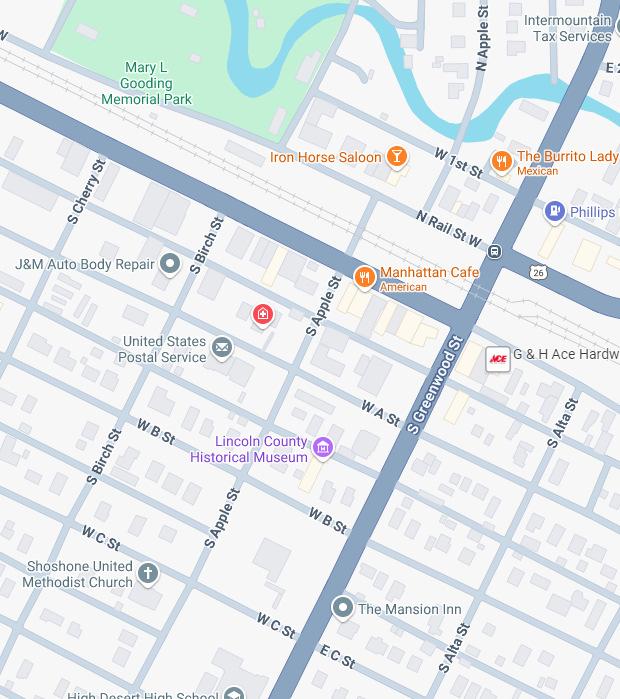
As a fine example of the use of local lava for building material in a group of related structures in Southern Idaho, Shoshone historic district is outstanding.
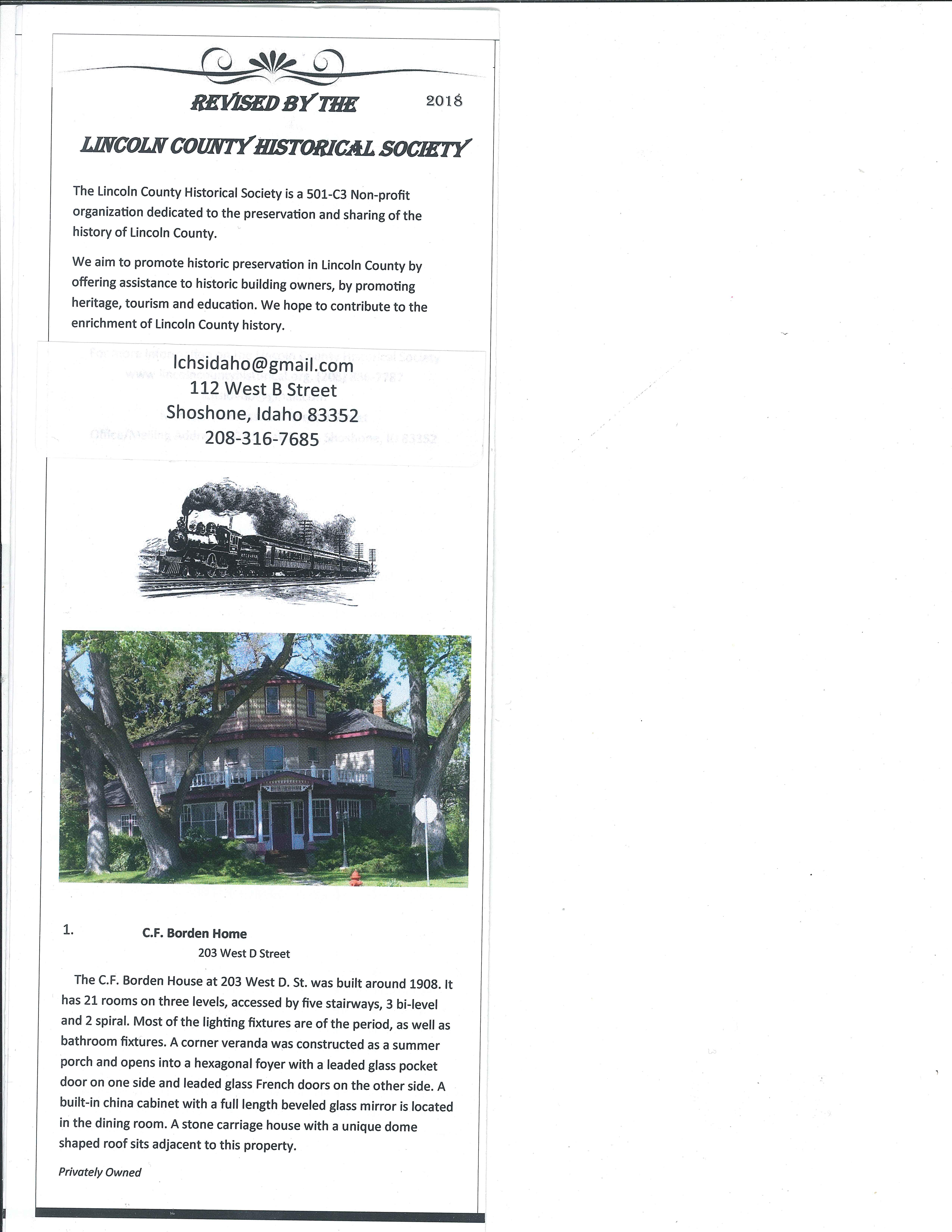
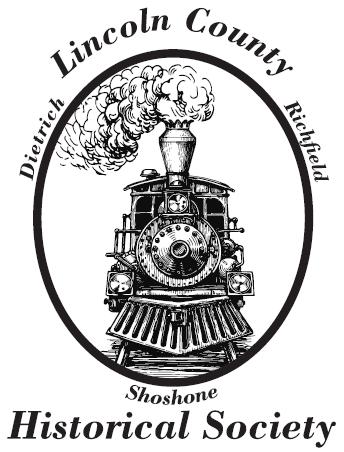
C.F. Borden Home
203 West D Street
The C.F. Borden House at 203 West D. St. was built around 1908.
It has 21 rooms on three levels, accessed by five stairways, 3 bi-level and 2 spiral.
Most of the lighting fixtures are of the period as well as bathroom fixtures.
A corner veranda was constructed then as a summer porch and opens into a hexagonal foyer with a leaded glass pocket door on one side and leaded glass French doors on the other side.
A built-in china cabinet with a full length beveled glass mirror is located in the dining room.
A stone carriage house with a unique dome shaped roof sits adjacent to this property.
United Methodist Church West C Street & South Apple
In 1884, Rev. J.W. Maxwell was appointed to Shoshone and in February 1885 a congregation was organized and a frame building was built that same year.
Construction of the “lava rock” church building began in 1904, finished in 1905, and dedicated on August 13, 1905 by Dr. T.C. Iliff of the “Extension Society” of the Methodist Episcopal Church.
The building is in use by the church, at this time.
This building is listed on the National Historic Register.
Lincoln County Courthouse 111 West B Street
This building was completed in 1904.
This large cubical building with truncated hip roof has two stories, and attic and a raised basement. The projecting central bay dominated the front, cutting the roof line as it raises to three stories in height, topped with a gable.
The double main doors are flanked and topped by small windows. On the third floor above the door is a pair of round-arched windows with a round window above. Brick quoins decorate the bay, and brick arches with trusticated stone terminations top double-hung sash windows.
Still in use today, you will find display case containing some of the early items used in the courthouse.
This building is listed on the National Historical Register.
The Mansion Inn
East C Street & South Greenwood
This home was build by Frank R. Gooding, Idaho Governor from 1905 until 1908 and US Senator from 1921 until 1928.
The city and county of Gooding are named for him.
The Gooding family emigrated to the United States from England in the 1800’s.
After trying their luck in Michigan and California, the family settled in the Shoshone area where Frank and his brothers became known as “Sheep Barons.”
Episcopal Church
110 West B Street






As early as 1886 occasional Episcopal services were held in Shoshone. The first records of an organized congregation are from 1889.
The church was formally established in November 1889. The church building was constructed in the summer of 1902.
A fire in the ____ caused considerable damaged to the interior requiring remolding to present form. The Jennings Parish House located next door was at the time the residence of the rector.
In recent years the Episcopal congregation has invited the E.C.L.A Lutheran Outreach to joint___ the church.
This building in listed on the National Historic Register.
Bethany Lodge #21, A.F. & A.M (Masonic Lodge)
112 West B Street
Sometime before October 1886 when Idaho was yet a territory, 10 Masons living in the Shoshone area sought to form a lodge. A dispensation was issued for Bethany Lodge UD located at Shoshone, Alturas County, Idaho Territory on October 12, 1886.
The meetings were held in a building belonging to the Knights of Labor located somewhere behind the present Manhattan Café. On September 18, 1887 a charter was issued to Lincoln Chapter No. 42, Order of the Eastern Star.
Built in 1902 and remolded in 1920, more work in mid-1950’s. Built as an opera house downstairs and a lodge room upstairs for the Knights of Pythias.
This building was used for the Carey Act Land Sales in 1904 were 25 people attended. Home of the Lincoln County Historical Society and Museum.
This building is listed on the National Historic Register as a lava rock structure.
The Soloaga Basque Boarding Home
201 East Avenue A Street
Built from 1904 to 1907 by the grandparents of Jack Soloaga, prominent Basque Sheep ranchers.
This two story white stucco building has 28 rooms. The private quarters for the family and the hotel-keeper are found on the first floor, towards the back of the building near the kitchen.
The second story contains dormitory-style rooms for boarders.
It is said to be haunted by Nuns who were unhappy with the goings on in the hotel as it serviced “all” the needs of the Basque sheepmen.
This building is privately owned.
J.C. Penny Company (2nd Time Around Antique Mall)
102 South Rail Street East
This building is significant as an unaltered example of early twentiethcentury commercial architecture and as an example of lava rock craftsmanship.
The building’s plateglass storefront, mezzanine lights, stepped false walls, brick corbelling and interior plan are typical of local commercial designs during this period. Built as an investment for Dr. W.H Buagh, the owner of the property, in 1918 by the Basque mason, Ignacio Berriochoea.
Dr. Baugh leased the building to the J.C. Penny Company that same year, and it has been used as a department store ever since. After J.C. Penneys closer, it re-opened by it manager, Mr. Douglas H. Hansen, who continued it’s operation as a department store.
This building is listed on the National Historic Register.
W.H. Baugh Opera House
125 South Rail Street West
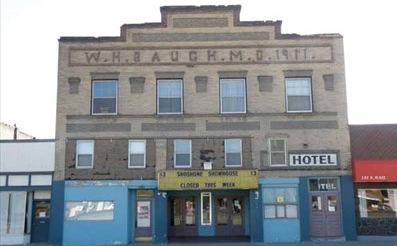
William H. Baugh was a well known physician and druggist of Shoshone. He established the only drug store in town.
He was also the local physician and surgeon for the Oregon Short Line Railroad Company.
W.H. Baugh built the opera house in 1911 that included a hotel above the theater. Many plays, entertainment and community events were held inside.
A movie screen was added and movies were viewed for many years until recently.
This building is privately owned.
109 North Greenwood
Shoshone’s Manhattan Café has a storied history and has served the hungry stomachs of several celebrities passing through.
Opened in 1890, it was known as the Opera House Café or the Chinaman’s Café due to the proximity to the nearby theater and the Asian American immigrants that owned the care for decades. It was unknown when or why the name changed to “Manhattan”
The restaurant operated in its original building until 1961 when a fire destroyed much of the original structure. When it reopened, the business expanded into portions of a neighboring building.
Some of the original structures remain in the building today.
McFall Hotel
230 North Rail Street West
The original building was constructed in 1900. Various owners added on to it throughout the years.
In it’s heyday, the hotel housed movie stars and presidents.
The hotel served as a stop over for the train and stage to Sun Valley.
Hemingway was rumored to have worked on one of his books. He and his associates were known to have favored the area for its hunting.
This building is listed on the National Historic Register and is privately owned.
Union Pacific Railroad Depot
304 North Rail Street West
Built in 1929, the Union Pacific Railroad Depot is a modest but pleasing example of Mission style, this depot probably reflects the great popularity of the Union Pacific’s Boise station of 1925. Replacement of the original tile roof somewhat detracts from the character of the building. The east half has the baggage and railway express wing, and is equipped with wide double doors of rustic design. The agent’s bay window is halftimbered and titled, and the passenger wing on the west end has a baroque predimented doorway with urn finials and the Union Pacific emblem in terra cotta. Engaged column support the entablature above this doorway. Brick quoins and lower walls contrast with the rough white stucco and the upper portions. The roof change note about is the only alteration.
Mary L. Gooding Park
North Rail Street West
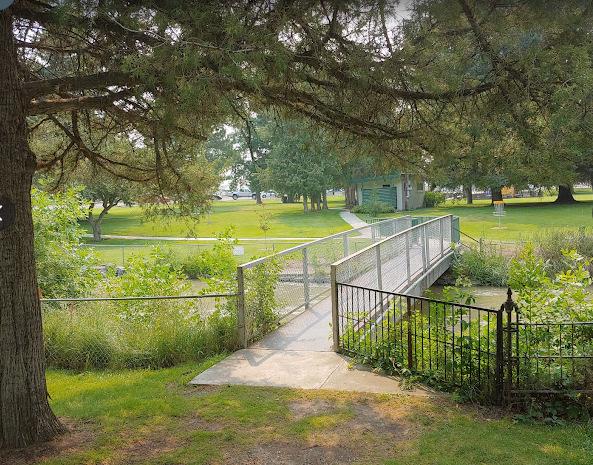
This beautiful park was created by Mary L. Gooding in the early 1920’s.
In 1928, Mary Gooding passed away from a sudden illness. In 1929 the Study Club gave the small park to the Villige of Shoshone and asked them to name it the Mary L. Gooding Memorial Park in memory of their good friend.
The Little Wood River flows through the park year round. Today, the park is used for multiple events and gatherings throughout the spring, summer and fall.
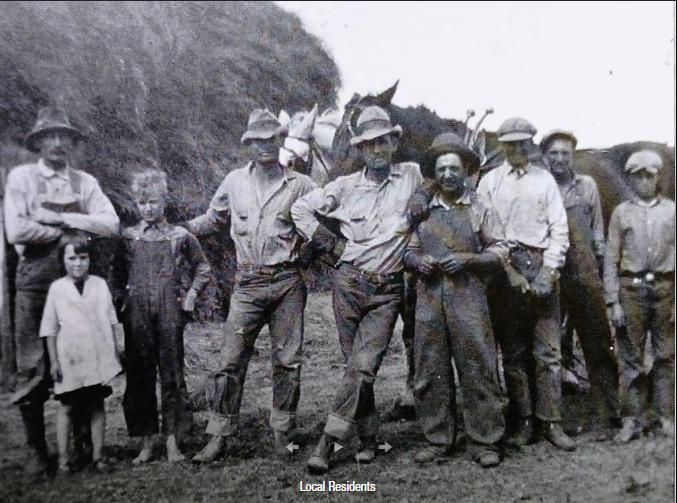
Lincoln County was Lincoln County was created on March created on March 18, 1895, from 18, 1895, from 18, 1895, from 18, 1895, from which the counties which the counties which the counties which the counties of Gooding, Jerome of Gooding, Jerome and Minidoka were and Minidoka were later taken. later taken. later taken. later taken. In 1919 In 1919 In 1919 In 1919 it reached its pre- it reached its present size of 1209 sq sent size of 1209 sq sent 1209 sq sent 1209 sq miles. miles. miles. miles. Shoshone, a Shoshone, a Shoshone, a Shoshone, a town divided by a town divided a railroad, with a railroad, a main street ap- main street ap- main street ap- main street approximately one proximately one proximately one proximately one hundred yards hundred yards hundred hundred wide, was named wide, was named wide, was named wide, was named the county seat. the county seat. the county seat. the county seat.
On March 4, 1863, Idaho Territory was created with W.H. Wallace appointed as Governor. The
First Idaho Territorial Legislature created 13 counties in the new territory including Alturas County, designating Esmeralda as County seat of the county for a short time before they made Rocky Bar the county seat until 1881 when an election moved the county seat to a young Hailey, ID in the booming Wood River Valley.
Alturas County nicknamed the Mother of Idaho Counties was the largest of the 13 counties and covered all the territory north of the Snake River to the Sawtooth Mountains. The eastern boundary was the Lost River, and the west boundary was the Boise County line just a few miles east of the town of Boise. Alturas County started to be divided beginning in 1889. In 1890, the year Idaho was given statehood, this area became part of Logan County, one of the counties split from old Alturas County. The county seat was set at Bellevue and John Hailey was selected chairman of the first Logan County board of commissioners.
The following year the first Idaho State Legislature created Alta and Lincoln counties from Logan County and what had remained of Alturas County. The county seat of Lincoln County was named Shoshone. The act creating Alta and Lincoln counties was declared unconstitutional three months after the counties were formed and the area reverted to Logan and Alturas counties for the next four years.
Finally in 1895 the Legislature created Blaine County out of the relic of Alturas County that remained and Logan County, then two weeks later formed Lincoln County with Shoshone again designated the county seat. Lincoln County was formed from the southern portion of Blaine County.
The boundaries of the second Lincoln County remained stable for nearly 20 years until 1913 when Gooding and Minidoka counties were formed. In the 1913 division most of the North Side First Segregation was made part of the Minidoka and the Gooding County line was two miles west of the town of Jerome. In 1919 a nine-year effort to have a county formed from the southern portion of Lincoln County was successful when on February 8, 1919 the county of Jerome was created by the Idaho Legislature.
Lincoln County lies within the great plains of the Snake River, broken and creased by ancient flows of lava. In the early days this section was a favorite winter range for stock summered in the hills and mountains to the north. Small tracts of land adjacent to the big and little wood rivers were farmed. With the construction of Irrigation dams and reservoirs agriculture became major industries.
